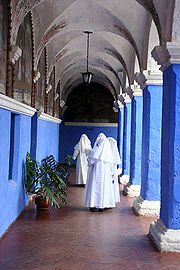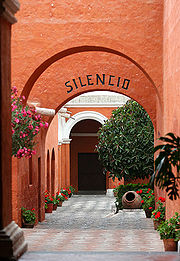
Santa Catalina Monastery
Encyclopedia

The Monastery
Monastery
Monastery denotes the building, or complex of buildings, that houses a room reserved for prayer as well as the domestic quarters and workplace of monastics, whether monks or nuns, and whether living in community or alone .Monasteries may vary greatly in size – a small dwelling accommodating only...
of Saint
Saint
A saint is a holy person. In various religions, saints are people who are believed to have exceptional holiness.In Christian usage, "saint" refers to any believer who is "in Christ", and in whom Christ dwells, whether in heaven or in earth...
Catherine
Catherine of Siena
Saint Catherine of Siena, T.O.S.D, was a tertiary of the Dominican Order, and a Scholastic philosopher and theologian. She also worked to bring the papacy of Gregory XI back to Rome from its displacement in France, and to establish peace among the Italian city-states. She was proclaimed a Doctor...
is a monastery of nun
Nun
A nun is a woman who has taken vows committing her to live a spiritual life. She may be an ascetic who voluntarily chooses to leave mainstream society and live her life in prayer and contemplation in a monastery or convent...
s of the Domincan
Dominican Order
The Order of Preachers , after the 15th century more commonly known as the Dominican Order or Dominicans, is a Catholic religious order founded by Saint Dominic and approved by Pope Honorius III on 22 December 1216 in France...
Second Order
Second Order (religious)
When referring to Roman Catholic religious orders, the term Second Order refers to those Orders of cloistered nuns which are a part of the mendicant Orders that developed in the Middle Ages.-St. Dominic:...
, located in Arequipa
Arequipa
Arequipa is the capital city of the Arequipa Region in southern Peru. With a population of 836,859 it is the second most populous city of the country...
, Peru
Peru
Peru , officially the Republic of Peru , is a country in western South America. It is bordered on the north by Ecuador and Colombia, on the east by Brazil, on the southeast by Bolivia, on the south by Chile, and on the west by the Pacific Ocean....
. It was built in 1580 and was enlarged in the 17th century. The over 20,000-square-meter monastery was built predominantly in the Mudéjar
Mudéjar
Mudéjar is the name given to individual Moors or Muslims of Al-Andalus who remained in Iberia after the Christian Reconquista but were not converted to Christianity...
style, and is characterized by its vividly painted walls. There are approximately 20 nuns currently living in the northern corner of the complex; the rest of the monastery is open to the public.
The foundress of the monastery
Monastery
Monastery denotes the building, or complex of buildings, that houses a room reserved for prayer as well as the domestic quarters and workplace of monastics, whether monks or nuns, and whether living in community or alone .Monasteries may vary greatly in size – a small dwelling accommodating only...
was a rich widow, Maria de Guzman. The tradition of the time indicated that the second son or daughter of a family would enter a life of service in the Church, and the monastery accepted only women from upper class
Upper class
In social science, the "upper class" is the group of people at the top of a social hierarchy. Members of an upper class may have great power over the allocation of resources and governmental policy in their area.- Historical meaning :...
Spanish families. Each nun here had between one and four servants or slaves, and the nuns invited musicians to perform in the monastery, gave parties and generally lived a lavish lifestyle. Each family paid a dowry
Dowry
A dowry is the money, goods, or estate that a woman brings forth to the marriage. It contrasts with bride price, which is paid to the bride's parents, and dower, which is property settled on the bride herself by the groom at the time of marriage. The same culture may simultaneously practice both...
at their daughter's admission to the monastery. The dowry expected of a woman who wised to enter as a choir nun--indicated by wearing a black veil--and who thereby accepted the duty of the daily recitation of the Divine Office
Divine Office
Divine Office may refer to:* Liturgy of the Hours, the recitation of certain Christian prayers at fixed hours according to the discipline of the Roman Catholic Church* Canonical hours, the recitation of such prayers in Christianity more generally...
, was 2,400 silver coins, equivalent to about $150,000 (U.S.) today. The nuns were also required to bring 25 listed items, including a statue, a painting, a lamp and clothes. The wealthiest nuns may have brought fine English china and silk curtains and rugs. Although it was possible for poorer nuns to enter the convent without paying a dowry, it can be seen from the cells that most of the nuns were very wealthy.
In 1871 Sister Josefa Cadena, O.P., a strict Dominican nun, was sent by Pope Pius IX to reform the monastery. She sent the rich dowries back to Europe, and freed all the servants and slaves, giving them the choice of either remaining as nuns or leaving. In addition to the stories of outrageous wealth, there are tales of nuns becoming pregnant, and amazingly of the skeleton of a baby being discovered encased in a wall. This, in fact, did not happen in Santa Catalina, and there are rumors of the same story in the nearby Santa Rosa monastery, as well.
At its height,the monastery housed approximately 450 people (about a third of them nuns and the rest servants) in a cloistered community. In the 1960s, it was struck twice by earthquakes, severely damaging the structures, and forcing the nuns to build new accommodation next door. It was then restored and opened to the public. This also helped pay for the installation of electricity and running water, as required by law.
 |
 |
Sources
- Lonely Planet Peru (2004). Charlotte Beech and Rob Rachowiecki. Lonely Planet Publications. ISBN 1-74059-209-3
- About.com South America for Visitors article
In Culture
The Santa Catalina monastery features in some detail in the second half of The Book of Human Skin by Michele Lovric.External links
- Santa Catalina Official Site (Spanish & English)
See also
- Casa del MoralCasa del MoralThe "Casa del Moral" is a large ancestral house built around 1730 in Arequipa, Peru. Favored by tourists, it is one of the best and well-preserved samples of baroque-mestizo civil architecture in Peru...
- Goyeneche Palace, Arequipa
- ArequipaArequipaArequipa is the capital city of the Arequipa Region in southern Peru. With a population of 836,859 it is the second most populous city of the country...
- Ana de los Angeles MonteagudoAna de los Angeles MonteagudoAna de los Angeles Monteagudo was born in Arequipa, Peru. She was a Dominican nun who was beatified by Pope John Paul II in 1985. She was a cloistered nun at the Santa Catalina Monastery. Her feast day is January 10th....

